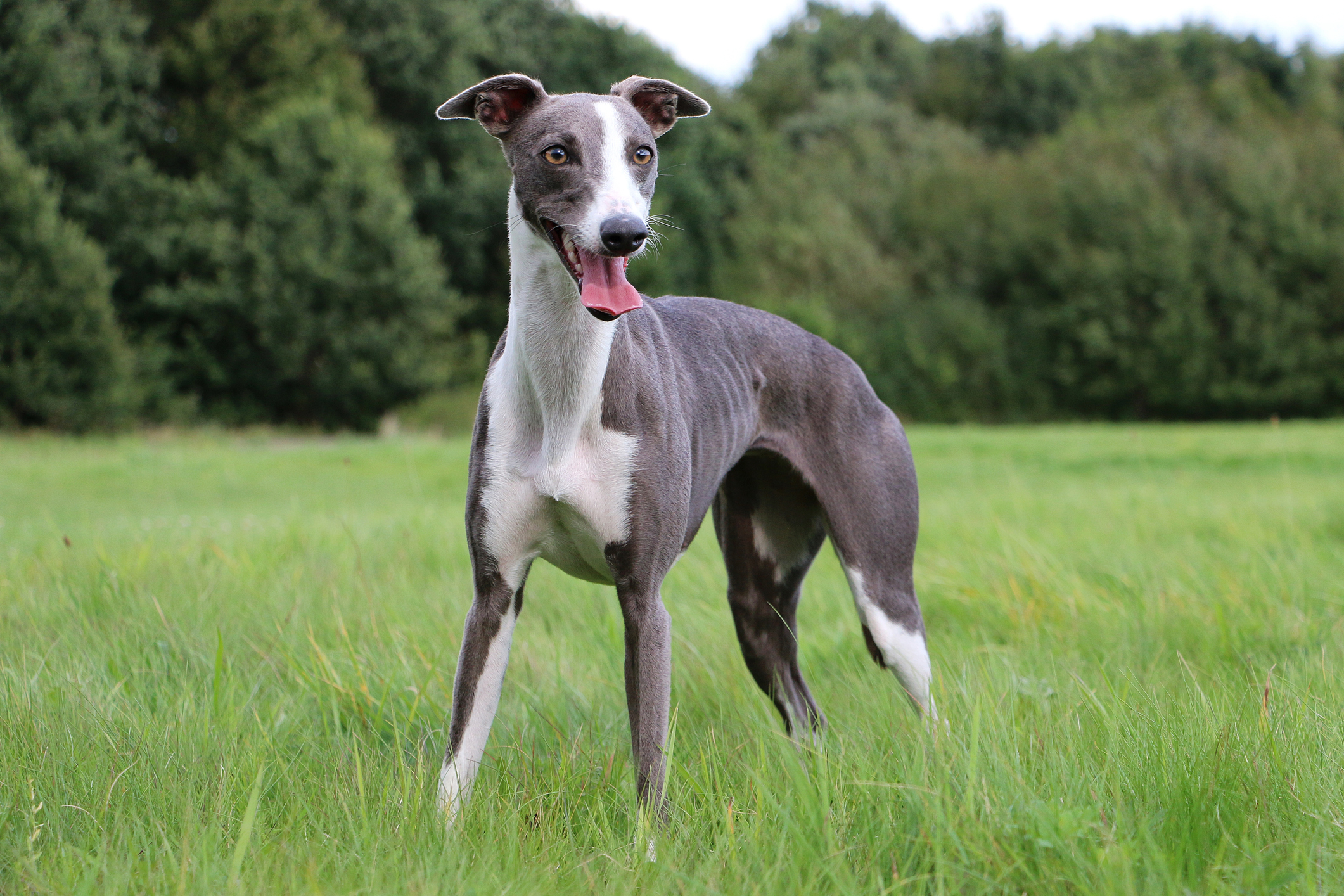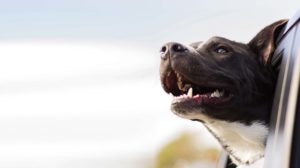Whippet| Traits | training | Typical health problems
This section outlines the Whippet traits, training and typical health problems.
Whippet| Breed highlights
| Breed: | Whippets are small to medium hounds, capable hunters of small animals like rabbits. They make endearing family companions with unique personalities and friendly dispositions. |
| Coat type: | The Whippet’s coat is very short, smooth, and soft. |
| Shedding: | They are typically low shedding but shed all year round. |
| Grooming: | The soft and short coat are often easy to care for, with a basic brushing once or twice a week being all it needs to stay looking and feeling good. |
| Activity level: | Bred as hunters, Whippet’s are active and intelligent so, they require a good hour or more of exercise each day, as well as activities to keep their minds busy when they are at home. Here are five ways to keep your whippet active indoors. |
| Apartment friendly: | They can be good apartment dogs provided they get plenty of exercise and attention. |
| Small children: | Whippets are generally considered to be good family pets, who are calm and good natured with children. Always supervise your dog when around small children. |
| Dog friendly: | If socialised correctly, Whippets typically get along with other dogs. They may be inclined to chase and hunt other small pets and wild animals. |
What type of breed is a Whippet?
The Whippet, also known as the English Whippet or Snap Dog is an elegant, medium-sized sighthound that makes loving family companions. Whippets are quiet and sensitive dogs with a gentle disposition. Affectionate and calm companions, they make a great addition to the family and are generally patient with children. They can be nervous when in unfamiliar environments, and despite being friendly, they may be a little shy around strangers.
History of Whippet
Whippets originated in England, where they were bred from crosses of Greyhounds and Italian Greyhounds to create the perfect medium-sized racing dog, that was cheaper to house and feed than the much larger Greyhound, hence the somewhat unjust description of Whippets as “the poor man’s Greyhound”. The Kennel Club granted the Whippet official breed recognition in 1891.
Whippet appearance and characteristics
As a sighthound, Whippets have the classic streamlined look of dogs belonging to this group, with a graceful neck, deep chest, and small waist. With a lean, athletic figure, long limbs, and an endearing face, they make for an elegant-looking hound. They come in a huge variety of colours and markings. They also come in a variety of sizes, with males ranging in height from 47cm to 57cm tall and in weight from 9kg to 19kg. Females are typically smaller than males. They have a sleek, short-haired coat that requires little maintenance.
Whippet personality and temperament
Although they are natural athletes capable of garnering impressive speed with their streamlined build, Whippets are content to relax at home once exercised. On top of this, Whippets are generally quiet dogs that don’t tend to bark much, making them an adaptable breed that is amenable to apartment and inner-city living.
Whippets, like many dog breeds, enjoy company and, when left alone, can develop signs of separation anxiety. Anxiety and other unwanted behaviours can also develop when Whippets don’t get enough exercise or have enough mental stimulation. So, like any pet, be sure to provide them with ample opportunities for company, exercise, and healthy activities.
Whippet traits
Whippets are generally calm and gentle, with plenty of energy bubbling under the surface, ready for a great gallop in the park, agility, or other sport. Whippets may not be as eager to please as some other breeds, meaning that more patience, time, and care should be taken in providing a calm and steady learning environment for a Whippet. Short training sessions are ideal, and consistency is key when training. Whippets are intelligent and respond to reward-based training. Training benefits pup and pup parent by strengthening the bond, gaining trust in one another, learning and growing together, as well as providing valuable mental and often physical stimulation.
Hunters by nature, Whippets may not be suitable for a household with other small pets like Guinea Pigs or birds. Always supervise Whippets very closely when around these animals.
Whippet Lifespan
Whippets generally have a lifespan of around 12 to 15 years.
The dos and don’ts of caring for a Whippet
Do: Brush at least once a week to keep coat soft and smooth and distribute natural oils. Whippets are low shedding but will shed all year round.
Don’t: Whippets do not need frequent bathing as overbathing can irritate the skin. Only bathe every few months or if your dog has become dirty after an outdoor adventure. Whippets don’t like being cold so ensure that you dry them thoroughly and keep them warm after a bath.
Do: Perform regular nail checks and cut when required. A trim is needed if you can hear your dog’s nails against the floor. PetSure’s Masterclass Video shows you the right way to master the technique. Also, make regular ear checks part of a grooming routine. Ear checks will allow you to spot problems like ticks, ear mites or an infection. Watch PetSure’s Masterclass if you would like tips on how to clean your dog’s ears.
Common conditions for Whippet
| Conditions | Symptoms can include~ | Highest cost for a single treatment* |
| Lameness | · Changes in gait affecting one or more limbs · History of trauma including heavy exercise · Holding up the affected leg(s) Reluctance to participate in normal activities | $4,677 |
| Bite Wound | · History of fight or altercation with another animal · Bleeding, weeping, redness, swelling · Pain | $5,406 |
| Skin masses | ·Lumps, bumps, swelling on the skin | $3,093 |
| Wound | · History of trauma · Bleeding, weeping, redness, swelling · Pain | $4,447 |
| Diarrhoea | · Loose or poorly formed stools · Increased frequency of passing stools ·Blood or mucous in stools Increased urgency to do stools | $2,769 |
Disclaimer: Reimbursement for these claims would be subject to limits, such as annual benefit limits or sub-limits, benefit percentage, applicable waiting periods and any applicable excess. Cover is subject to the policy terms and conditions. You should consider the relevant Product Disclosure Statement or policy wording available from the relevant provider.
* Please note that the values calculated are based on all claims for that condition and medically related conditions in each calendar year.
Types of pet insurance from PetSure
| Policy type | Policy description |
| Accidents | This product provides cover for specified accidental injuries up to an annual policy limit. Most policies will reimburse a stated Benefit Percentage that is typically 80% of eligible vet bills. Some condition sub-limits may also apply, with all annual limits resetting each year when the policy is renewed. It’s important to know that only defined accidents as listed in the policy’s Product Disclosure Statement will be covered (other conditions will not be covered). More information on what is typically covered and not covered in our find a policy page. |
| Basic care | This product provides limited cover for both specified accidental injuries and illness conditions, with a stated Benefit Percentage that can range from 60-90%. Treatments and medications for eligible conditions are typically covered subject to the applicable policy limits. Claimable conditions have an annual condition limit , meaning once the condition limit (subject to the annual benefit limit) has been reached in an annual policy period, costs relating to that condition will need to be covered entirely by the policyholder. However, annual benefit limits and applicable annual condition limits reset on renewal each year. More information on what is typically covered and not covered in our find a policy page. |
| Comprehensive / Accident and Illness | This product provides comprehensive cover for both specified accidental injuries and illness conditions, with a stated Benefit Percentage that will typically range from 70-85%. You can claim up to an annual maximum limit each year, which resets on renewal. Sub-limits for certain items may also apply. More information on what is typically covered and not covered in our find a policy page. |
Pet insurance can help by covering a portion of the eligible vet bill if the unexpected happens. Because it is difficult to predict the costs of veterinary care, it can help to have measures in place to help prepare for the unexpected. Check out our partner network and explore our policy tools to find a pet insurance policy. Not all conditions or items are covered by Pet Insurance. Refer to the applicable Product Disclosure Statement for information about coverage and exclusions.
Frequently Asked Questions
Every individual animal is different and can experience various health problems throughout life. According to PetSure Claims data 2017 -2022, Whippets rank in the top 20 breeds most at risk of developing Mitral Valve Disease. It is thought to be an inherited condition in this breed.
Bred as hunters, Whippet’s are active and intelligent so require a good hour or more of exercise each day, as well as activities to keep their minds busy when they are at home.
Whippets are generally considered to be a quiet breed; however, they are also clever and may learn that barking is a great way to get your attention and get what they want.
The top five names for Whippets, according to PetSure claims data for Whippets born in 2022 are:
1. Charlie
2. Maggie
3. Luna
4. Alfie
5. Archie
Insurance products are issued by The Hollard Insurance Company Pty Ltd ABN 78 090 584 473, AFSL 241436 (Hollard) and/or PetSure (Australia) Pty Ltd ABN 95 075 949 923, AFSL 420183 (PetSure) (from 8 May 2023 only), administered by PetSure and promoted and distributed through their authorised representatives and distribution partners.
Any advice provided is general only and does not take into account your individual objectives, financial situation or needs. Cover is subject to the policy terms and conditions. Please consider the Product Disclosure Statement (PDS) to ensure this product meets your needs before purchasing, or choosing to continue with the product. PDS and Target Market Determination available on our partners’ websites. Meet our partners at petsure.com.au/partners.
References
10 things only a Whippet Owner Would Understand, American Kennel Club
Severity of Mitral Valve Degeneration Is Associated with Chromosome 15 Loci in Whippet Dogs
Pet insurance can help by covering a portion of the eligible vet bill if the unexpected happens. Because it is difficult to predict the costs of veterinary care, it can help to have measures in place to help prepare for the unexpected. Check out our partner network and explore our policy tools to find a pet insurance policy.
Not all conditions or items are covered by Pet Insurance. Refer to the applicable Product Disclosure Statement for information about coverage and exclusions.








